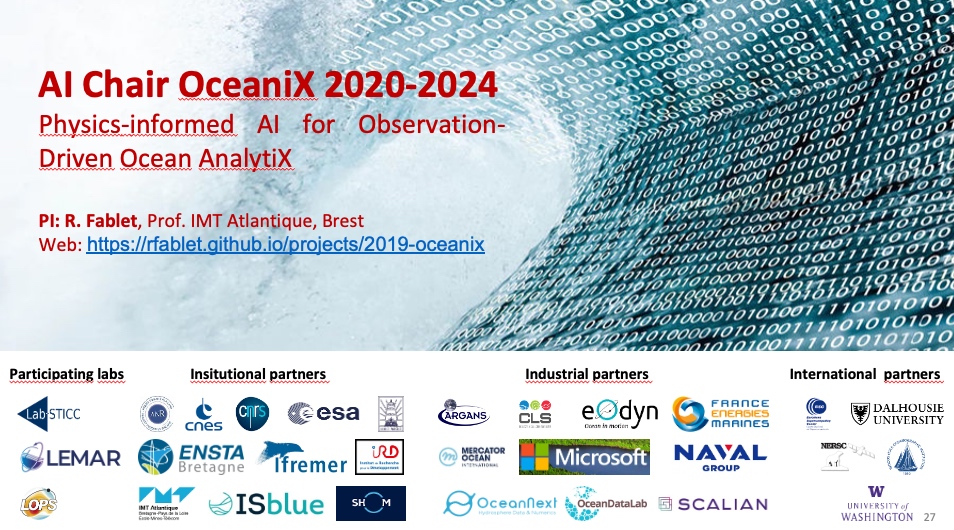ANR Chair OceaniX 2020-2024
Published:
ANR AI Chair OceaniX (2020-2024) “Physics-Informed AI for Observation-driven Ocean AnalytiX” (short presentation)
Summary.
 Covering more than 70% of earth’s surface, the oceans, especially the upper oceans (e.g., the first few hundred meters below the oceans’ surface), play key roles for the regulation of the earth climate (e.g., climate change) as well as for human societies (e.g., marine resources and maritime activities). Despite ever-increasing development of simulation and observation capabilities leading to ocean big data, our ability to understand, reconstruct and forecast upper ocean dynamics and police maritime activities remains limited for key societal challenges (e.g., catastrophe monitoring, global current changes, fishery, energy production, illegal activities). Building upon the cross-fertilization of the cutting-edge expertise of Ifremer and Univ. of Brest in marine science and technology and IMT Atlantique in engineering/data science, OceaniX aims to explore and develop AI-driven strategies and frameworks for the next-generation of self-adaptive multi-platform ocean monitoring and surveillance systems and services with an emphasis on observability and sampling optimality issues for complex dynamics and processes, including extremes and long-term properties. This general objective will rely on bridging model-driven paradigms underlying physical sciences and data-driven learning-based approaches at the core of AI to learn novel computationally-efficient and physically-sound representations of complex dynamical systems. Supported both by institutional and industrial partners, we aim to develop a cutting-edge dual expertise in AI and Ocean science with a particular emphasis on academy-industry synergies and international attractiveness.
Covering more than 70% of earth’s surface, the oceans, especially the upper oceans (e.g., the first few hundred meters below the oceans’ surface), play key roles for the regulation of the earth climate (e.g., climate change) as well as for human societies (e.g., marine resources and maritime activities). Despite ever-increasing development of simulation and observation capabilities leading to ocean big data, our ability to understand, reconstruct and forecast upper ocean dynamics and police maritime activities remains limited for key societal challenges (e.g., catastrophe monitoring, global current changes, fishery, energy production, illegal activities). Building upon the cross-fertilization of the cutting-edge expertise of Ifremer and Univ. of Brest in marine science and technology and IMT Atlantique in engineering/data science, OceaniX aims to explore and develop AI-driven strategies and frameworks for the next-generation of self-adaptive multi-platform ocean monitoring and surveillance systems and services with an emphasis on observability and sampling optimality issues for complex dynamics and processes, including extremes and long-term properties. This general objective will rely on bridging model-driven paradigms underlying physical sciences and data-driven learning-based approaches at the core of AI to learn novel computationally-efficient and physically-sound representations of complex dynamical systems. Supported both by institutional and industrial partners, we aim to develop a cutting-edge dual expertise in AI and Ocean science with a particular emphasis on academy-industry synergies and international attractiveness. Keywords: data-driven representations, complex dynamical systems, deep learning, inverse problems, upper ocean dynamics, maritime activities, spacebone and in situ sensors, multi-platform and multi-source data, geophysical extremes, observability, predictability.
Institutional partnerships: ANR, CNES, ENSTA Br., Ecole Navale, ESA, Ifremer, IMT Atlantique, IRD, ISblue, SHOM
Industrial partnerships: ACRI-ST/ARGANS, CLS, Eodyn, ITE-FEM, Mercator-Ocean, Microsoft, Naval Group, ODL, OceanNext, Scalian
International collaborators: Prof. S. Brunton (Univ. Washington, USA), Prof. S Matwin (Dalhousie Univ., Canada), Prof. A. Mahadevan (WHOI, USA), L. Bertino (NERSC, Norway), F. Doblas-Reyes (BSC, Spain)
Role in the project: Principal Investigator (co-PIs: B. Chapron (Ifremer, LOPS), X. Carton (UBO, LOPS), L. Méméery (CNRS, LEMAR))
Operating budget: 2M€ over 5 years (including 9 PhD scholarships)
